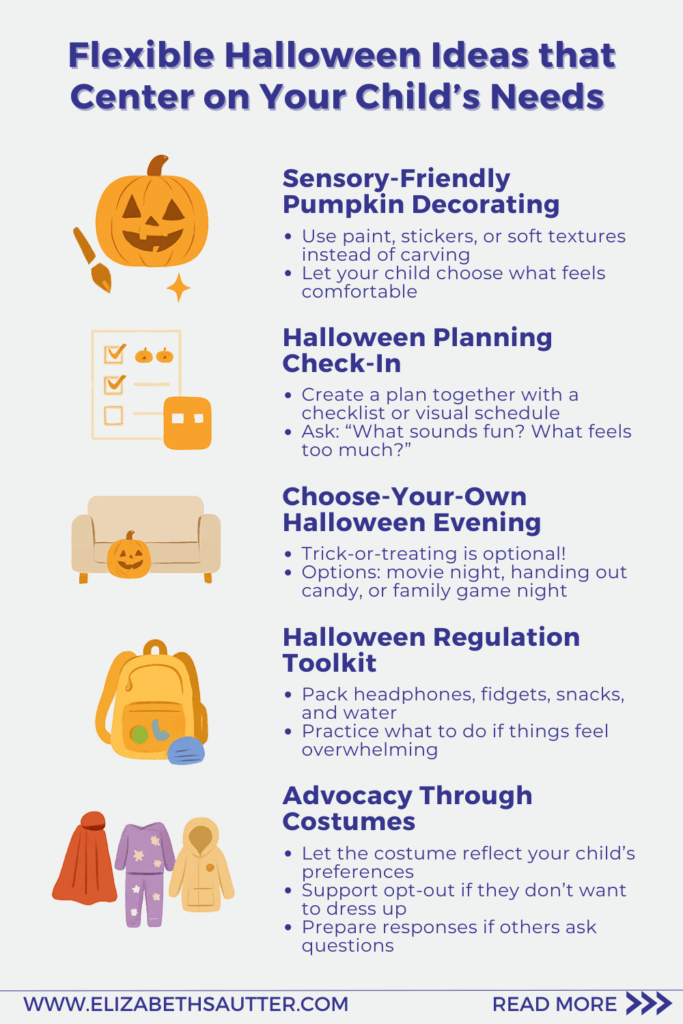Rethinking Halloween: It's Okay to Do Things Differently
Halloween doesn’t have to look traditional to be meaningful. Discover inclusive ways to support your child’s emotional regulation, self-awareness, and advocacy through neurodiversity-affirming Halloween activities.
Halloween often comes with a set of expectations, trick-or-treating, noisy parties, crowded neighborhoods, but those typical traditions may not work for every child or teen. And that’s okay.
Halloween can bring sensory overload, social stress, or pressure to conform. Instead of pushing to fit into a one-size-fits-all model of celebration, we can empower our kids to notice what feels right for them, speak up about their needs, and make choices that feel safe, fun, and meaningful.
This shift is part of helping them to build self-awareness, self-advocacy, and flexible thinking, skills that are essential not only during holidays but in everyday life.

Flexible Halloween Ideas that Center Your Child’s Needs
These activities draw on principles from my book, Make Social and Emotional Learning Stick: Practical Activities to Help Your Child Manage Emotions, Navigate Social Situations, and Reduce Anxiety (2023). They encourage them to notice what’s happening inside themselves, emotionally and physically, and to make choices that support regulation and confidence.
1. Sensory-Friendly Pumpkin Decorating
Supports: Self-awareness, sensory exploration, creativity
Instead of traditional pumpkin carving, which can be messy, smelly, or overwhelming for some, offer sensory-friendly options like painting, using stickers, or decorating with soft craft materials. Invite your child to choose the tools and textures that feel best to them.
Ask:
- “How does that feel in your hands?”
- “Do you want to keep going or take a break?”
This builds body awareness and shows that their preferences are valid and important.
2. Halloween Planning Check-In
Supports: Executive functioning, emotional regulation, advocacy
Sit down with your child a few days before Halloween and make a plan together. Use visuals, checklists, or simple verbal prompts depending on what works best for them. Offer open-ended questions like:
- “What sounds fun to you this year?”
- “Is there anything that feels like too much?”
- “Would you rather stay in and have a movie night?”
This gives a child a chance to anticipate, prepare, and co-create a plan that supports their needs, and gives you both a chance to practice collaborative decision-making.
3. Choose-Your-Own Halloween Evening
Supports: Flexibility, autonomy, confidence
Your child doesn’t have to trick-or-treat, wear a costume, or go to a party. Maybe they’d rather stay in with a cozy blanket and a favorite movie, or hand out candy at the door, or build a Halloween fort and read books by flashlight.
Help your child reflect on what feels good to their body and brain:
- “What kind of evening would feel calming or fun for you?”
- “Is there a way to celebrate that would work better for your energy level or mood?”
This teaches that honoring your needs is not just acceptable, it’s a life skill.
4. Create a Halloween Regulation Toolkit
Supports: Emotional regulation, preparation, co-regulation
Prepare a “just in case” regulation kit together. You might include noise-canceling headphones, fidgets, chewy snacks, water, or a calming visual support. Even if you don’t need it, knowing it’s available can provide reassurance.
Involve them in choosing what goes inside. Talk through situations that might come up (e.g., unexpected crowds, loud sounds) and what their plan might be to feel safe and supported.
This helps your child feel empowered and equipped, not reactive.
5. Advocacy Through Costumes
Supports: Identity, creative expression, confidence
If your child wants to wear a costume, support their creative choices, even if they don’t follow the “usual” Halloween trends. Let it reflect how they feel, what they’re interested in, or simply what feels most comfortable to wear.
And if they don’t want to wear a costume at all? That’s okay too.
Invite conversations like:
- “What would help you feel most like you tonight?”
- “How can we let others know what works best for you?”
That might include preparing a short explanation, using visual cards, or simply practicing saying “no thank you.”
You Matter Too: Regulate With, Not Just For
You don’t have to keep everyone calm. You get to care for yourself too.
Try:
- A deep breath before responding
- A walk or warm drink to reset
- A simple mantra: “I can stay grounded, even if the day feels wobbly.”
When your nervous system feels safe, it becomes a steady anchor for your family. Presence matters more than perfection.
Halloween Can Still Be Special... On Your Terms
The most powerful lesson we can teach them is that they are worthy of honoring their needs. Whether Halloween includes costumes and candy, or a quiet night at home, the most important thing is that it works for your child and your family.
By supporting flexible thinking, building body awareness, and encouraging advocacy, you’re helping them develop lifelong tools for well-being and emotional intelligence.
Want More Ideas Like These?
Grab the digital copy of my book, Make Social and Emotional Learning Stick: Practical Activities to Help Your Child Manage Emotions, Navigate Social Situations, and Reduce Anxiety. It’s filled with simple, meaningful strategies that can be woven into daily routines and seasonal celebrations alike.
Learn more about the book here
Let Halloween be a chance to connect, reflect, and support your child in celebrating in a way that feels right for them.

